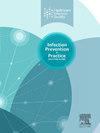Improving ventilation hygiene in wards for immunocompromised patients: a workflow comparison of traditional and innovative duct cleaning methods
IF 1.8
Q3 INFECTIOUS DISEASES
引用次数: 0
Abstract
Introduction
For a vulnerable hospital population, hospital ventilation systems can pose a risk if not maintained correctly. Dust accumulation in air ducts can create environments that allow fungal spores, such as Aspergillus.spp, to thrive, potentially leading to severe infections like invasive aspergillosis. Our study aimed to develop a safe protocol for cleaning ventilation systems on an active ward in healthcare settings.
Methods
We conducted a comparative evaluation of ventilation duct cleaning in adjacent hospital rooms. In one room, the ducts were accessed from within the room using a traditional brushing method, while in the other room, the ducts were primarily accessed from outside using a novel method including the use of newly developed low speed brushes and point extraction of debris. Air quality was monitored by counting particles every 15 minutes in 100-liter samples using a calibrated air sampler and collecting microbiological specimens before and after the cleaning process.
Results
In-room cleaning caused a significant spike in airborne particles of all sizes, along with a modest increase in Aspergillus spp. spores, which took an hour to return to baseline levels. Conversely, external access for cleaning did not notably impact room air quality.
Conclusion
These findings highlight the risks associated with internal duct cleaning, especially for patients who are vulnerable to airborne fungal infections. External duct access proves to be a safer alternative, ensuring minimal disruption to the air quality in patient care areas. This study supports the necessity of strategic planning in hospital ventilation maintenance to protect vulnerable populations.
改善免疫功能低下患者病房的通风卫生:传统和创新管道清洁方法的工作流程比较
对于脆弱的医院人群,医院通风系统如果维护不当可能会造成风险。空气管道中灰尘的积累会为曲霉等真菌孢子的滋生创造环境。Spp,茁壮成长,可能导致严重的感染,如侵袭性曲霉菌病。我们的研究旨在制定一个安全的方案,清洁通风系统在一个活跃的病房在医疗保健设置。方法对相邻病房通风管道清洁情况进行对比评价。在一个房间中,使用传统的刷刷方法从房间内进入管道,而在另一个房间中,主要使用一种新颖的方法从外部进入管道,包括使用新开发的低速刷刷和点提取碎片。空气质量监测是通过每15分钟在100升样品中使用校准空气采样器计数颗粒,并收集清洁过程前后的微生物标本。结果室内清洁导致空气中各种大小的颗粒显著增加,同时曲霉孢子也略有增加,这些孢子花了一个小时才恢复到基线水平。相反,外部清洁通道对室内空气质量没有显著影响。结论这些发现强调了内部管道清洁的风险,特别是对于易受空气真菌感染的患者。外部管道通道被证明是一种更安全的选择,确保对患者护理区域空气质量的干扰最小。本研究支持医院通风维护策略规划的必要性,以保护弱势群体。
本文章由计算机程序翻译,如有差异,请以英文原文为准。
求助全文
约1分钟内获得全文
求助全文
来源期刊

Infection Prevention in Practice
Medicine-Public Health, Environmental and Occupational Health
CiteScore
4.80
自引率
0.00%
发文量
58
审稿时长
61 days
 求助内容:
求助内容: 应助结果提醒方式:
应助结果提醒方式:


